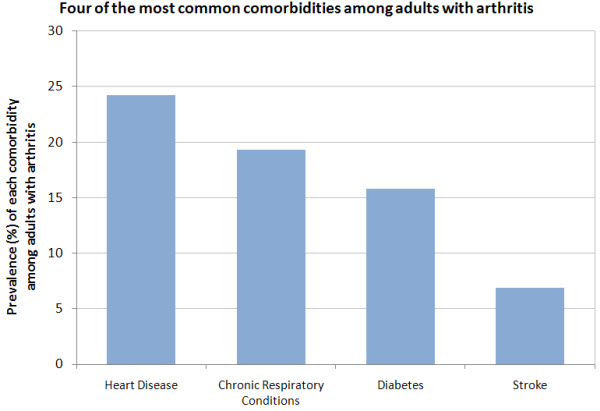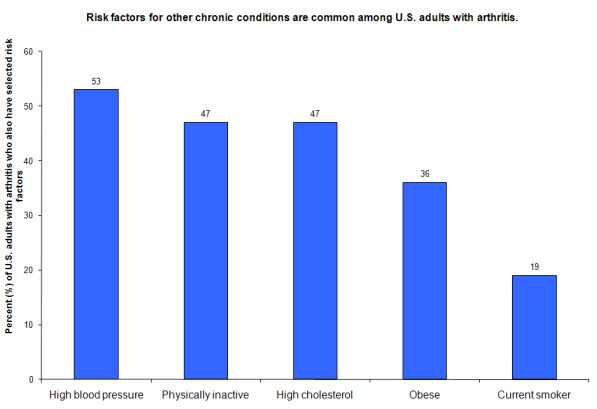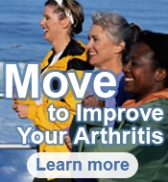
Comorbidities
The presence of more than one disease or condition in the same person at the same time.
Conditions described as comorbidities are often chronic or long-term conditions. Other names to describe comorbid conditions are coexisting or co-occurring conditions.
The CDC Arthritis Program examines comorbidities in the following two ways:
- Comorbidities among people with arthritis. Everyone in this group has arthritis, plus at least one additional condition.
- Arthritis among people with other chronic conditions. A subset of people with other chronic conditions who also have arthritis.
Comorbidities among people with arthritis
CDC reports that 47% of U.S. adults with arthritis also have at least one comorbid condition (2007 National Health Interview Survey).
Figure 1— Four of the Most Common Comorbidities Among Adults With Arthritis

Arthritis is very common, affecting 50 million Americans.1 According to the graph, in 2007, 11.2 million, or nearly one in four adults with arthritis (24%), also had heart disease. The most common comorbidity among adults with arthritis was heart disease. Among people with arthritis 19% (9.0 million) also had chronic respiratory conditions and 16% (7.3 million) also had diabetes. Of the four conditions studied, stroke was the least common condition and affected 3.2 million people with arthritis.
Data source: National Health Interview Survey, 2007 Source: Murphy L, Bolen J, Helmick CG, Brady TJ. Comorbidities Are Very Common Among People With Arthritis. Poster 43. 20th National Conference on Chronic Disease Prevention and Control, CDC February 2009.
Why do people with arthritis have so many comorbidities?
No one can say exactly why people with arthritis have so many comorbidities. Results from this and other studies suggest that arthritis and other chronic conditions share some of the same non-modifiable risk factors (e.g. age) and modifiable risk factors (e.g. obesity). Arthritis also may directly cause physical inactivity, which can lead to obesity and other chronic conditions.
Figure 2—Risk Factors For Other Chronic Conditions
Are Common Among U.S. Adults With Arthritis

Data source: National Health Interview Survey, 2007 Source: Murphy L, Bolen J, Helmick CG, Brady TJ. Comorbidities Are Very Common Among People With Arthritis. Poster 43. 20th National Conference on Chronic Disease Prevention and Control, CDC February 2009.
Figure 2 shows that high blood pressure is reported by more than half of (53%) U.S. adults with arthritis. High blood pressure is associated with heart disease, the most common comorbidity among adults with arthritis (shown in Figure 1). Figure 2 also shows that about 1 in 5 (~19%) of U.S. adults with arthritis is also a current smoker. Smoking is associated with chronic respiratory conditions, the second most common comorbidity among adults with arthritis (shown in Figure 1).
What can people with arthritis and comorbidities do?
The CDC Arthritis Program recommends self-management education programs and physical activity programs that provide important benefits for people with arthritis whether or not they have comorbidities. These programs are designed to teach people the skills they need to take charge of their conditions and engage in effective, joint-friendly physical activity. Improving self-management skills and increasing physical activity can even have added benefits for their other chronic conditions.
Learn more about heart disease and arthritis.
Learn more about diabetes and arthritis.
How do comorbidities affect medical costs among people with arthritis?
Comorbidities have a substantial impact on increased medical expenditures among people with arthritis.
Between 1997 and 2005, there was a 22% increase in medical expenditures among people with arthritis.2 This increase in medical expenditures was attributable to an increase in the number of people with arthritis who had comorbid conditions.1
Arthritis among people with other chronic conditions
Did you know?
- In the total U.S. population 22% of adults have arthritis.1 But arthritis is much more common for people who have some other conditions, for example—
- Fifty-seven percent of people with heart disease also have arthritis (about 11 million people).
- Fifty-two percent of people with diabetes also have arthritis (about 7.3 million people).
Data source: 2007 National Health Interview Survey
Learn more about heart disease and arthritis.
Learn more about diabetes and arthritis.
Information for health care providers about arthritis and comorbidities
Comorbidities can make life more difficult and limited for the affected person. The presence of comorbidities can also make disease management and treatment more complicated and more expensive. When arthritis is a comorbidity, particularly with diabetes3 heart disease,4 and obesity5 it may impede efforts to be more physically active, which is an important part of disease management. Most adults face the following common barriers to being more physically active—
- Lack of time.
- Competing responsibilities.
- Lack of motivation.
- Difficulty finding an enjoyable activity.
Adults with arthritis face the following additional, disease-specific barriers:
- Concerns about aggravating arthritis pain.
- Fear about causing further joint damage.
- Uncertainty about which types and amounts of activity are safe for their joints.
Health care providers should consider whether arthritis-specific barriers contribute to physical inactivity in their patients, and can help those patients learn to overcome arthritis-specific barriers to physical activity by providing appropriate advice and referrals to evidence-based physical activity programs that are designed for adults with arthritis. A physical activity fact sheet and information detailing the importance of physical activity for people with arthritis are available.
Also, research suggests that people with arthritis may experience short-term increases in pain when they initiate an exercise program but that continued physical activity results in a long-term reduction of symptoms.6 Overcoming the initial increase in pain and fears about joint damage are important concerns for people with arthritis and are especially important for people with arthritis and additional chronic conditions.
Health care providers and their patients may benefit from an integrated approach to chronic disease management, including referral to self-management education programs that address arthritis and other chronic conditions. Greater integration of intervention efforts by health care providers, payers, and health departments might better address the effects of arthritis and comorbidities.
Several exercise programs, including EnhanceFitness®, the Arthritis Foundation Exercise Program, and the Arthritis Foundation Aquatics Program, are available in many communities and are appropriate for adults with arthritis and adults with arthritis plus other chronic conditions (e.g., heart disease and diabetes).
In addition, people with arthritis can engage in joint-friendly physical activity on their own or with friends. Some of the joint-friendly physical activities that are appropriate for adults with heart disease and arthritis are the following:
- Walking.
- Swimming.
- Riding a bike.
For more information on joint-friendly exercise programs, visit CDC’s Arthritis Web site at http://www.cdc.gov/arthritis/intervention. A physical activity fact sheet and information detailing the importance of physical activity for people with arthritis are available.
Self-management education programs
Self-management education programs teach people techniques to manage their chronic diseases, such as arthritis and comorbidities, on a day-to-day basis. Specially tailored self-management education interventions, such as the Chronic Disease Self Management Program and the arthritis-specific Arthritis Foundation Self-Help Programhelp people with arthritis learn to manage arthritis pain and discuss how to increase physical activity safely.
- Chronic Disease Self-Management Program (CDSMP) is an effective self-management education program for people with chronic health problems. The program specifically addresses arthritis, diabetes, lung and heart disease, but the skills taught are useful for managing a variety of chronic disease. This program was developed at Stanford University. CDSMP workshops are held in community settings and meet 2 1/2 hours per week for 6 weeks. Workshops are facilitated by two trained leaders, one or both of whom are lay people with a chronic disease themselves. This program covers topics such as the following:
- Techniques to deal with problems associated with chronic disease.
- Appropriate exercise.
- Appropriate use of medications.
- Communicating effectively with family, friends, and health professionals.
- Nutrition.
- How to evaluate new treatments.
Participants who took CDSMP demonstrated significant improvements in—
- Exercise.
- Communication with physicians.
- Self-reported general health.
- Health distress.
- Fatigue.
- Disability.
- Social/role activities limitations.
More information about CDSMP is available. Locate your state arthritis program, which may help you find a class.
- Arthritis Foundation Self-Help Program (AFSHP) is an effective self-management education intervention for people with arthritis. Developed by Dr. Kate Lorig of Stanford University, the course helps people learn and practice the different techniques needed to build an individualized self-management program and gain the confidence to carry it out. The 6-week course consists of weekly 2-hour sessions guided by two trained instructors who follow a detailed protocol. There is a science base that demonstrates the positive impacts of participation in the Arthritis Foundation Self-Help Program. Participants report a 20% decrease in pain even 4 years after course participation. To find out about availability in your area you can check with the Arthritis Foundation or view this map to locate your state arthritis program.
References:
1. Cheng YJ, Hootman JM, Murphy LB, Langmaid GA, Helmick CG. Prevalence of Doctor-Diagnosed Arthritis and Arthritis-Attributable Activity Limitation – United States, 2007–2009. MMWR 2010;59(39):1261–1265. html pdf [1.61 MB]
2. Cisternas MG, Murphy LB, Yelin EH, Foreman AJ, Pasta DJ, Helmick CG. Trends in Medical Care Expenditures of US Adults with Arthritis and Other Rheumatic Conditions 1997 to 2005. J Rheumatol. 2009;36(11):2531–8. abstract
3. J Bolen, J Hootman, CG Helmick, L Murphy, G Langmaid, CJ Caspersen. Arthritis as a Potential Barrier to Physical Activity Among Adults with Diabetes --- United States, 2005 and 2007. MMWR 2008;57:486–9. html pdf [1.3Mb]
4. Bolen J, Murphy L, Greenlund K, Helmick CG, Hootman J, Brady TJ, etal. Arthritis as a Potential Barrier to Physical Activity Among Adults With Heart Disease — United States, 2005 and 2007. MMWR 2009;58:165–9. html pdf [1.25Mb]
5. Hootman JM, Murphy LB, Helmick CG, Barbour KE. Arthritis as a potential barrier to physical activity among adults with obesity—United States, 2007 and 2009. MMWR 2011;60(19):614–618.
6.Wilcox S, Der Ananian C, Abbott J, Vrazel J, Ramsey C, Sharpe PA, etal. Perceived exercise barriers, enablers, and benefits among exercising and nonexercising adults with arthritis: results from a qualitative study. Arthritis Rheum. 2006;55(4):616–27. abstract html
Get email updates
To receive email updates about this page, enter your email address:

Contact Us:
- Arthritis Program
Mailstop K-51
4770 Buford Hwy NE
Atlanta, GA 30341-3724
- Phone: 770.488.5464
Fax: 770.488.5964 - cdcinfo@cdc.gov


